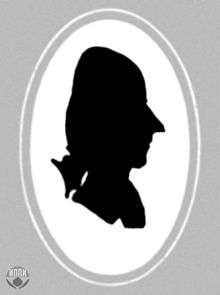Dmitri Alekseyevich Gallitzin

Prince Dmitri Alexeievich Gallitzin FRS (21 December 1728 – 16 March 1803) was a Russian diplomat, art agent, author, volcanologist and mineralogist. He was a supporter of the recognition of the United States, and participated in the drafting of the League of Armed Neutrality. He was the first Russian educated people that made specific proposals on the abolition of serfdom in Russia.
Life
Gallitzin, born in Saint Petersburg, was the son of Prince Alexei Ivanovitch Gallitzin and Princess Gagarin. In 1754 he was appointed at Collegium of Foreign Affairs. In 1760 he moved to Paris, where he made the acquaintance of Diderot, Voltaire, d'Alembert, and Claude Adrien Helvétius. After the coup in 1762 Catherine the Great appointed him ministre plenipotentiair to France. In 1764 he introduced Étienne-Maurice Falconet to the tsarina. It was through Prince Dmitri that Catherine purchased the destitute Diderot's library (1766), with the stipulation that he take care of the 2900 books, at an excellent salary.[1] Though nominally an Orthodox Russian, he accepted and openly professed the principles of a rationalist philosophy. Gallitzin was one of the first Russians that promoted the ideas of the Physiocrats.
Gallitzin was involved in the Polish question and recalled to Russia as it seems to discuss another appointment. Passing through Aachen, he met the Countess Adelheid Amelie von Schmettau, only daughter of the Prussian Field-Marshal Samuel von Schmettau. The nineteen-year-old Countess had accompanied Prince Augustus Ferdinand of Prussia (brother of Frederick the Great) and his wife Margravine Elisabeth Louise of Brandenburg-Schwedt to the spa. After her mother's consent they married in a chapel at Aix-la-Chapelle (Aachen) on 28 August 1768.[2] On honeymoon the couple proceeded to St. Petersburg. Gallitzin acquired for the Hermitage many paintings from Heinrich von Brühl (1768), and in the following years from François Tronchin (1770) and Louis Antoine Crozat (1772).
In 1769 Prince Gallitzin was appointed ambassador to Holland. He left the capital; on route they stopped in Berlin, where their first child, Princess Marianna was born (7 December 1769). Their second child, Prince Demetrius was born on 22 December 1770 in The Hague.[2]
Houdon's portrait of Diderot, commissioned by the Russian ambassador Dmitrii Alekseevich Golitsyn, and shown in terracotta at the salon of 1771, was a critical milestone for the young sculptor. The prominence of the influential subject, the prestige of the patron, and the artistic power of the bust itself brought him to the attention of a wide circle inside France and at foreign courts—a power elite that formed his base of support in the absence of crown commissions.[3]
About two years later, the Ambassador and his wife hosted Diderot (two months in 1773) on his way to Saint Petersburg. On his way back in 1774 Diderot spent half a year in the Dutch Republic. In the same year the couple split and Princess moved to a country house between The Hague and Scheveningen, the better to oversee raising her children in a way J.J. Rousseau had promoted in his "Emil". There she met often with Frans Hemsterhuis, the philosopher, her teacher and council. Princess Wilhelmina of Orange, wife of stadtholder William V, and her eldest son were frequent visitors.[1]
In July 1782 Tsarevich Paul and his wife came to visit the Dutch Republic and were received by Gallitzin. In December 1782 the Ambassador had to leave Den Haag. His capacities as a diplomat during the First League of Armed Neutrality were not estimated as much as his scientific interest in mechanics and minerals.[4] In 1783 he left Turin and returned to the Dutch Republic.
Galitzin owned one of the biggest electrostatic machine, made at his own design. He corresponded with Comte de Buffon. Prince Gallitzin was elected in the Academy of Sciences Leopoldina in 1795; a Fellow of the Royal Society on 19 April 1798. In the summer of 1799 Golitsyn was elected president of the Mineralogical Society of Jena. In spite of serious illness, the prince took in his work seriously. Before his death, Golitsyn gave his collection to the Mineralogical Museum in Jena (a weight of 1850 kg, received in December 1802), and requested to place the samples according to the system of René Just Haüy.
Recognition
Member of the director of the Dutch Society of Sciences (1777); Honorary member of the St. Petersburg Academy of Sciences (1778); Foreign Member of the Brussels Academy of Sciences (1778); Foreign member of the Swedish Academy of Sciences (1788); Foreign member of the Berlin Academy of Sciences (1793); Member of the German Academy of Natural Scientists (Leopoldina, Halle ) under the name of Maecenas III (1795); Foreign member of the Royal Society of London (1798); A member of the St. Petersburg Free Economic Society (1798); President of Jena Mineralogical Society (1799-1803).
References
- 1 2 "Life of Demetrius Augustine Gallitzin, prince and priest [microboth]".
- 1 2 "CATHOLIC ENCYCLOPEDIA: Demetrius Augustine Gallitzin".
- ↑ "Jean Antoine Houdon (17411828)". C1 control character in
|title=at position 26 (help) - ↑ Gedenkschriften van Gijsbert Jan van Hardenbroek, heer van Bergestein ... enz. (1747-1787), Deel IV, p. 178-179; 239-240.